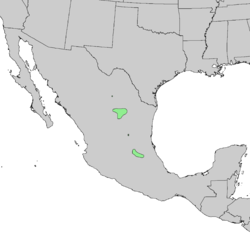| Pinus pinceana | |
|---|---|
 | |
| Scientific classification | |
| Kingdom: | Plantae |
| Clade: | Tracheophytes |
| Clade: | Gymnospermae |
| Division: | Pinophyta |
| Class: | Pinopsida |
| Order: | Pinales |
| Family: | Pinaceae |
| Genus: | Pinus |
| Subgenus: | P. subg. Strobus |
| Section: | P. sect. Parrya |
| Subsection: | P. subsect. Cembroides |
| Species: | P. pinceana |
| Binomial name | |
| Pinus pinceana Gord. | |
 | |
| Natural range of Pinus pinceana | |
Pinus pinceana, with the common names weeping pinyon and Pince's pinyon pine, is a species of conifer in the family Pinaceae.
